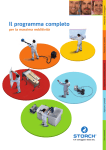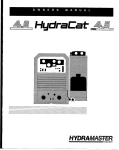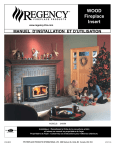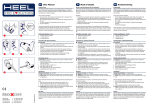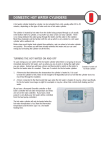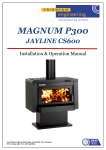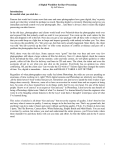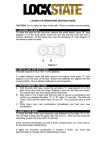Download OPERATING INSTRUCTIONS - Pivot Stove & Heating
Transcript
OPERATING INSTRUCTIONS For PYROCLASSIC IV Your PYROCLASSIC IV works in a different way than other fires. We highly recommend that you read these instructions so that you will enjoy the unique benefits of your Pyroclassic IV. PLEASE DO NOT USE THESE INSTRUCTIONS TO LIGHT YOUR FIRST FIRE, INSTEAD SAVE THESE INSTRUCTIONS SOMEWHERE FOR YOUR FUTURE REFERENCE. IMPORTANT NOTE Pyroclassic fires have been in production for over 25 years here in New Zealand. Our experience, along with other New Zealand manufacturers, is that most problems relating to obtaining maximum efficiencies come from loading the fire with wet or damp firewood. The New Zealand Home Heating Association report that as much as 95% of complaints received, are as a result of poor fuel. We strongly suggest that you read the section regarding Firewood. IMPORTANT AND USEFUL INFORMATION FOR THE OWNER AND OPERATOR Thank you for purchasing the PYROCLASSIC IV freestanding wood fire. Here at PYROCLASSIC we take pride in manufacturing this high quality, low emission fire which enjoys a history of proven reliability and high efficiencies. To help you obtain all the benefits that the PYROCLASSIC IV can offer, we ask you to ensure that the following four important steps are performed: o The PYROCLASSIC IV should be installed by a qualified installer, and require that your Warranty card is duly completed by that person. o The wood you use in the PYROCLASSIC IV should be a good quality, dry wood with a moisture content of 25% or less, 12% to 18% is ideal for clean efficient heat. We have dedicated a complete page of useful information on dry wood and we request that you read this information. o The operating instructions are full of interesting information that even an experienced fire lighter will find useful, please read them. o The Warranty card needs to be signed by both the installer and you, as the purchaser and sent back to us at PYROCLASSIC FIRES LTD. ACCESSORIES SUPPLIED WITH PYROCLASSIC IV FIRE RAKE A 710mm long rake is supplied. It has a curved edge to match the shape of the fire chamber, which will allow easy movement of the ashes inside the curved fire chamber. RE-USABLE FIRE STARTERS Two re-usable fire starters are supplied. (See section “YOU’RE NOW READY FOR YOUR FIRST FIRE”) please note: Never soak a HOT fire starter in methylated spirits Place the soaked fire starter in the front of the fire chamber just underneath the front of your kindling. When fire has started use tongs to remove and place somewhere safe to cool down. When fire starter is COLD, place into jar of methylated spirits. Warning: NEVER leave methylated spirits near the lit fire, NEVER add spirit to a hot fire starter and NEVER squirt spirit or any liquid fuels directly into the fire chamber. EARTHQUAKE RESTRAINTS If the Pyroclassic IV is not installed on the Pyroclassic raised hearth then it will need to use the two angle iron restraints that measure 50mm x 50mm with 2 8x20mm bolts which are supplied as earthquake restraints. These are attached to the slots provided in the back plate of the Pyroclassic IV fire to suitable anchoring points on the floor. TUBE OF ANTI-SEIZE GREASE This is used to grease the door knob spindle. Use only a small amount, the 28grams supplied should last the life of the fire. WARRANTY FORMS Please make sure that both copies of your warranty paperwork have been filled out fully with your details, details of who you purchased the fire from, your installer’s details for both the fire and the wetback if applicable. FIREWOOD (A MUST READ) Any wood burner not operating properly creates high emissions and will not heat your home properly. Simple methods to ensure clean burning and efficient heating are: Plan Ahead. Stock up on wood 6-12 months before winter to burn dry well seasoned wood. Any firewood from 25 to 100mm (1” to 4”) in diameter cut up to 450mm (17”) lengths is good fuel. Shorter pieces are less efficient and not as convenient to use. Insist on 350 to 450mm logs. Let your wood merchant know what you want for your money. Do not burn wet or green wood, plastic, domestic refuse, painted or chemically treated wood, plywood, driftwood, particle board or coal in your Pyroclassic IV – these release dioxins when they burn. Stack wood loosely in a dry place so air can pass freely through the pile. Never use driftwood, painted or chemically treated wood as these release dioxins when they burn. Burn smaller, hotter fires which are more efficient. Never overload your wood burner by placing too much wood in the fire. CAUTION: THE USE OF SOME TYPES OF PRESERVATIVE-TREATED WOOD AS FUEL CAN BE HAZARDOUS. DO NOT USE FLAMMABLE LIQUIDS OR AEROSOLS TO START OR REKINDLE THE FIRE. DO NOT USE FLAMMABLE LIQUIDS OR AEROSOLS OR PLACE THESE IN THE VICINITY OF THIS APPLIANCE WHEN IT IS OPERATING. DO NOT STORE FUEL WITHIN THE HEATER INSTALLATION CLEARANCES. THIS APPLIANCE SHOULD NOT BE OPERATED WITH A CRACKED GLASS. THIS APPLIANCE SHOULD BE MAINTAINED AND OPERATED AT ALL TIMES IN ACCORDANCE WITH THESE INSTRUCTIONS. OPERATING TIPS USE OF TURBO SLIDE The Turbo slide is the part on the front of your fire with the Pyroclassic IV name on it, it covers a hole that allows start up air to enter quickly to get your fire going. To open the hole move the Turbo slide to either the left or right; the open hole works like a pair of old fashioned bellows. When your fire has caught and is going well, cover the hole with the Turbo slide by putting the Turbo slide into the middle position. To make sure the Turbo slide works well, remember to keep a very small area around the hole (i.e. the very front part of the fire chamber) free of ash or char. Simply push back the build-up a little – doesn’t have to be much just enough to keep the hole clear and let it work how it should with the rake. If the hole is clogged it will not work as it should and the fire may be hard to start. A little bit of housekeeping pays off with a quick starting, free breathing hot fire. IMPORTANT: THE TURBO SLIDE IS FOR THE INITIAL START-UP FIRES AND FOR USE TO HELP IGNITE FRESH FUEL IF REQUIRED ONLY. ONCE A HOT FIRE HAS STARTED CLOSE THE TURBO SLIDE AIR SUPPLY HOLE BY SLIDING THE TURBO SLIDE TO THE MIDDLE POSITION. YOU WILL ENJOY LOW EMISSIONS, HIGH THERMAL EFFICIENCY AND CONSERVE YOUR WOOD SUPPLY. NOT FOLLOWING THESE INSTRUCTIONS CAN RESULT IN DAMAGE TO THE AIRTUBES INSIDE THE FIRE CHAMBER. LOADING FIRE WOOD The door allows you to insert logs in the only correct way for burning wood – lengthwise. For best results do not insert wood sideways! Wood grows from the ground up, not parallel with the ground. For best results you should burn it from end to end, along the grain. Across the grain wood is nature’s best insulation, good for building houses and to resist fire. LOAD LIMITER Inside, along the top of the fire chamber is a load limiter, this is designed to restrict the operator overloading the fire chamber. A tip for using your Pyroclassic IV responsibly (low emissions/no smoky fires) is to burn small hotter fires. Add wood as required, this is how you can control the heat output of your fire. CONTINUOUS AND OVERNIGHT OPERATION The Pyroclassic IV is a heat store and fast, small fires can store excess heat in the refractories. The unit then continues heating like an electric storage heater. For overnight runs, load no more than 2 or 3 hardwood logs about 45 minutes before bed time. When the flames subside, push ash and glowing char to the back of the fire chamber, check that the Turbo slide is closed. In this way you get most of the heat out of your firewood. In the morning, dig hot ember out of the ash, raking it close to the door, but remember to keep the Turbo slide hole clear to allow air in to rekindle the fire, (works like a pair of bellows). Add some kindling and a few larger pieces on top then with the Turbo slide open, you should have a roaring fire in less than 10 minutes. You may not be able to maintain an overnight fire with soft wood. OPERATING TIPS CURVED RAKE PROVIDED Use the rake to push the ash away from the door bringing forth only hot ember on which to place another log or two when required. When raking, avoid plugging the Turbo slide inlet with char or ash (this is the hole covered by the Turbo slide below the door). DOOR/DOORKNOB DO NOT run the heater with the door open. It will never reach the correct operating temperature and can be very dangerous. To protect the door gasket, DO NOT OVERTIGHTEN THE DOORKNOB. The door seals with little pressure and may be hard to open when the unit is very hot. Load it after it cools down, the door then opens easily. The Pyroclassic IV stores the excess heat from flames so you will get most of this heat back over several hours. The best heater output control is by how much and how often you add dry fuel. Frequent reloading may result in high room temperatures. You will soon know how much and how often to add fuel. The Pyroclassic IV is designed to save on firewood and to keep emission levels to the minimum. Remember it stores excess heat and this is released into the room even when the fire is low. If you are finding the door knob too hot when trying to refuel your fire then you are probably trying to refuel too soon, the door knob is a great indicator of what’s happening with your heater. If you can’t reload then you don’t need to yet. If your door knob is starting to show signs of charring then you are probably burning your fire too continuously near the door and possibly need to close the Turbo slide sooner. PYROCLASSIC IV IS SELF-REGULATING. The vigorous fire near the loading door automatically slows down as the burning front advances through the firebox. Each cycle ends with only ash near the door and hot ember at the far end of the firebox. CHIMNEY SWEEPS The flue may plug up if you don’t run the fire correctly. Do not allow chimney sweeps to take the fire apart or to replace any chimney components supplied by Pyroclassic Fires Ltd. We shall not assume responsibility for any damages caused by any unauthorised changes. Always ensure that the original full flow cowl is fitted after any cleaning. Do not add or change anything on this cowl. Our full flow cowl, i.e. No cap prevents dripping of condensed acids down the chimney. If you think it looks like something is missing to stop the rain getting in don’t worry, the flue discharges far more water as vapour released from the firewood, (approx 1 litre every 8kgs) so don’t worry about any rain that you think might be able to get into your flue. AIR INLETS It is much easier and cheaper to light a new fire than to clean a flue full of creosote. DO NOT block any fixed air inlets, this can result in damage to the fire. BURNING WITH THE PYROCLASSIC IV Solid wood does not burn, it must change to gas and vapour before any burning can take place. The change occurs by heating to high temperatures to make the best gas fuel. Low temperatures will make smoke and tars that are simply unburnt fuel. The Pyroclassic IV is called a North/South burning fire so the fire is started in the front of the fire chamber and continues along the length of the wood to the rear, make sure logs are placed ‘longways’ into the fire chamber – NOT sideways. Your objective is to achieve a high temperature in the fire chamber quickly, which is easy using the Turbo slide and dry wood, you will never get it to burn right if you try starting fires with green or wet wood. The only fuel authorised for use with this appliance within the Clean Air Zones is well seasoned wood with a moisture content of 25% or less on wet weight basis, 12-18% is ideal. PYROCLASSIC IV MAINTENANCE GREASING THE DOORKNOB SPINDLE A small tube of graphite grease is enclosed, this should be applied sparingly and only occasionally to the spindle of the doorknob. Ashes from the fire have a gritty texture and over time this can cause wear on the doorknob spindle. Use a tiny amount of grease to lubricate the spindle which can be applied with a matchstick. NB: only a small amount is needed, if too much is used it will melt and dribble down causing an unsightly stain. CLEANING THE DOOR GLASS Scrunch up 2 pieces of damp newspaper, dip one in cold fire ashes and rub over the inside of glass, use the other one to rub over glass to clean dirt off. If you allow the ash to build up on your glass it will be difficult to clean. Do this in the morning before rekindling the fire; the glass will be coolish at this time. To keep the glass clear, get into the habit of cleaning it very regularly as this will maintain the glass and prevent ashes from being fused onto the glass due to intense heat in the firebox. CAUTION: THIS APPLIANCE SHOULD NOT BE OPERATED WITH A CRACKED GLASS FLUE & FLUE CLEANING The Pyroclassic IV flue will not foul up unless you are burning wet wood, burning fuel with an inadequate air supply, or when the firebox does not reach normal operating temperature. If cleaning is necessary (i.e. if you notice smoke coming out of the open door), do not allow the chimney sweep to dismantle the chimney or take the cook top off. All that is necessary is to push a brush from the top of the chimney down the flue. Do not remove the soot because it will just burn up in the heater’s top chamber the next time you run your fire. YOU’RE NOW READY FOR YOUR FIRST FIRE Your first fire may give a poor performance and the fire may even go out. Do not be alarmed! This is due to the ceramic firebox drying out. The ceramic contains a small amount of moisture and needs heat to dry out. You may even notice a small amount of moisture appear under your fire on the hearth after the first burn, this is normal. During the first firing the special heat-resistant paint cures, this may result in smoke and odour being given off. It does not last for long and will not happen again, but it is a very good idea to have ventilation in the room during the first firing. STARTING YOUR FIRST FIRE 1. Soak the reusable fire starters in Methylated spirits. We recommend you store them in an airtight jar filled with Meths. 2. Slide the Turbo slide to the far right or far left position. This opens the air hole inside the door and allows air to flow through acting like an old fashioned pair of bellows. 3. Place DRY kindling and a few small logs in the front of the fire chamber leaving a clear space in front of the air inlet hole. 4. Place a soaked fire starter just under the kindling at the front of the fire chamber and light it. 5. Close the door. 6. Once the fire is burning really well and you have a nice bed of hot embers move the Turbo slide to the central position (to cover the air inlet hole). 7. When opening the door to load more wood slide the Turbo slide to the far left or right position, and continue as in number 6. NB: The fire starter can be retrieved from the fire once it has stopped burning. Use metal tongs to retrieve the fire starter and place on a non-combustible surface i.e. a block of stone, concrete or a tile. When cold it can be placed inside the Jar of Methylated spirits ready for the next firing. TROUBLE SHOOTING SLOW STARTUP Turbo Slide (air inlet slide closed). Open the slide by moving to either the left or right. Check that the start-up hole is free of ash and char on the inside, push back any build-up with the rake. The start-up air supply hole allows air to enter the fire chamber like a pair of old fashioned bellows, if the hole is clogged with ash and char it will not work. A little bit of housekeeping pays off with a quick free-breathing startup fire. Check for air leakage around the cook top, around the flue collar, and in the flue pipe joints. Air bypassing the fire chamber reduces draft. Repair air leaks. Large wet logs loaded on few remaining hot coals; use dry kindling to start fire quickly. DO NOT USE WET FUEL. Insufficient draft. Review chimney construction. Warm, humid conditions outside or an inversion layer. Wait until the flue pipe heats-up. DENSE SMOKE Plastic materials, fire retardant-treated wood or high resin content wood loaded in fire chamber. Burn seasoned wood only. Hot fire chamber was overloaded with wood treated with fire retardant. Do not use such fuel. EARLY MORNING PALE BLUE SMOKE Caused by burning off small creosote deposits formed by premature banking of the fire the night before. SMOKE ENTERS ROOM Negative pressure in the room – possibly caused by kitchen exhaust fan or severe pressure difference in a windstorm. Open window to equalise the pressure. Severe down draft due to surrounding structures, hills, or trees. Use a full flow cowl. Flue is plugged up. Clear the obstruction. GASES & SMOKE ENTER ROOM WHEN DOOR IS OPENED Flue is plugged-up, may require sweeping Loading door opened during maximum degassing of fuel. Wait until flames disappear. Very cold flue temperature, allow initial start up fire to warm flue pipes. HIGH FUEL CONSUMPTION Loading door is not airtight. Check the gasket. Incorrect operation. Operator forgetting the units heat storage capacity. Add logs less often. Turbo slide being left open for long periods. LOW WATER HEATING CAPACITY A poor performing, low temp fire. This could be caused by one of the points raised above. Hotflow wetback incorrectly fitted. Check the layout, must have continuos rise once installed. DOORKNOB CHARRING This will naturally happen slowly over many years use, however the process can be undesirably accelerated by the user burning with the Turbo slide open continuously and having the fire right up to the door, please read the operating instructions again and use the Pyroclassic IV correctly. TROUBLE SHOOTING HAIRLINE CRACKS APPEAR IN FIREBOX This is a natural way to relieve built-up stress in refractories; it has no effect on operation, performance, or useful life of the unit. The firebox is an arch structure, the most stable and permanent construction known. BACK PUFFING OR MINOR GAS EXPLOSION Rake not used to bring hot char forward, wood burning at the wrong end. Use the rake as per Operating Instructions. Turbo slide not opened after re-loading large cold logs. Explosive substance, battery, aerosol container, etc loaded into the fire chamber. Don’t do it, this is very dangerous!! NOISY OR PULSATING WATER HEATING Improperly constructed water-heating circuit. Check the layout. Reread your copy of the Wetback Instructions. UNABLE TO KEEP FIRE OVERNIGHT Loading door not airtight or turbo start slide left open. Using too small sticks of low density wood (softwoods). Dr J F C Walker, Canterbury University: “Low-burn tests in New Zealand using Pinus Radiata as a fuel rarely last 150 minutes, while tests in Australia with high density hardwoods may burn twice as long….” DOOR LOCK HARD TO OPERATE Apply a small amount of high temperature grease to thread (grease with graphite or molybdenum disulphide). Over tightning the door screw lock. Door seals with minimum pressure. Do not over tighten. Over tightening the door handle shortens gasket life. The PYROCLASSIC IV is trying to tell you “wait – no need to load me now”. Do not load very hot stove. ASH SPILLS & DE-ASHING De-ash when fire chamber is relatively cool. Use shovel to slowly empty the fire chamber. Ash almost always contains some hot ember. Never use a vacuum cleaner. Obtain a metal (non-combustible) ash container with a lid. Store outside on concrete or bare ground. Pot Ash can be great for your garden if your soils are acidic, use only ash from a cooled fire which used good quality wood. THANK YOU FOR PURCHASING ONE OF OUR FIRES PLEASE ENJOY YOUR PYROCLASSIC IV IT LOVES HIGH FIRE CHAMBER TEMPERATURES Pyroclassic Fires Ltd PO Box 28-150, Havelock North, 4157 Showroom: 8 St Andrews Rd, Havelock North, 4130 Ph: (06) 877 0175 Fax: (06) 877 7501 www.pyroclassic.co.nz












